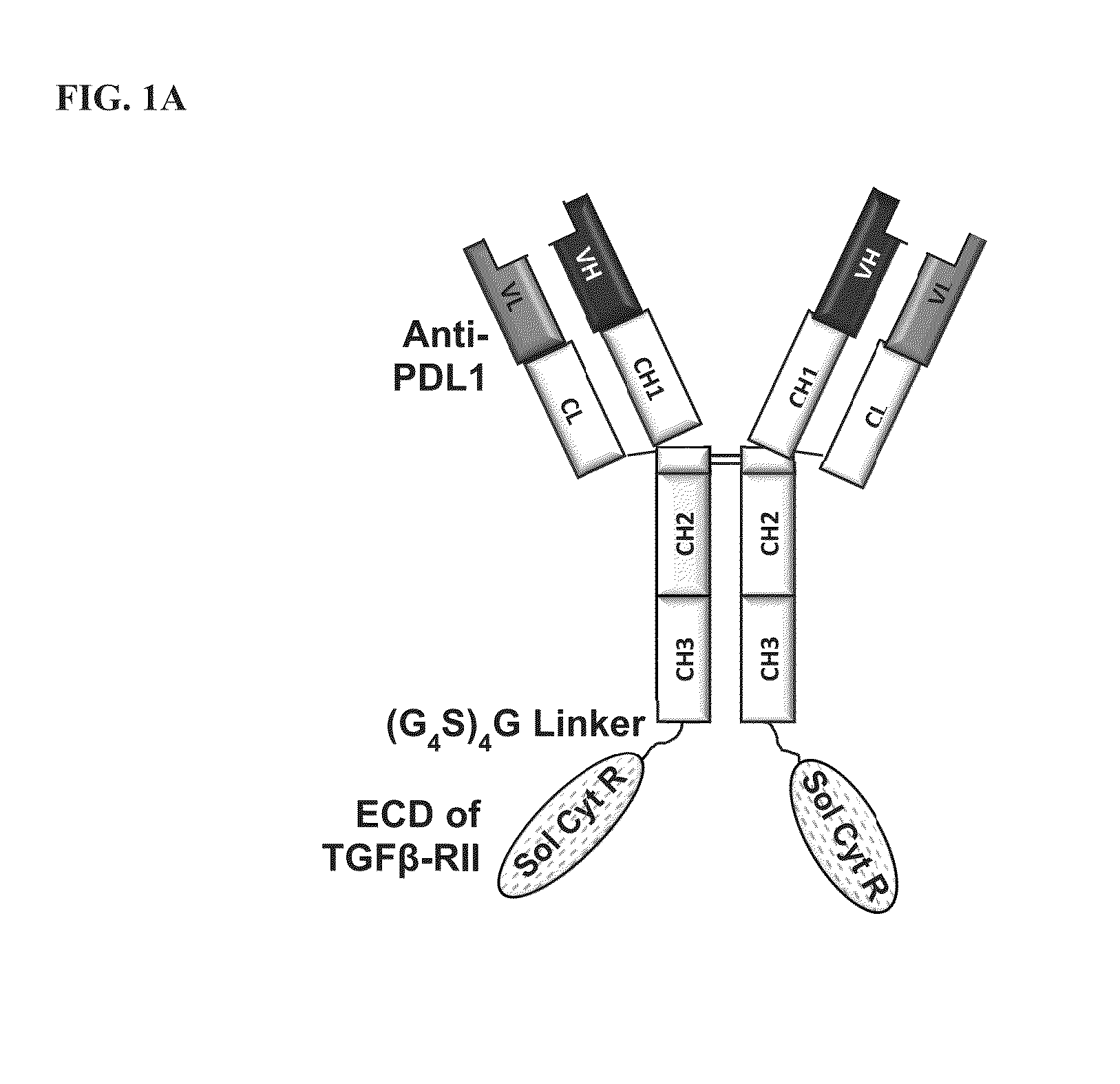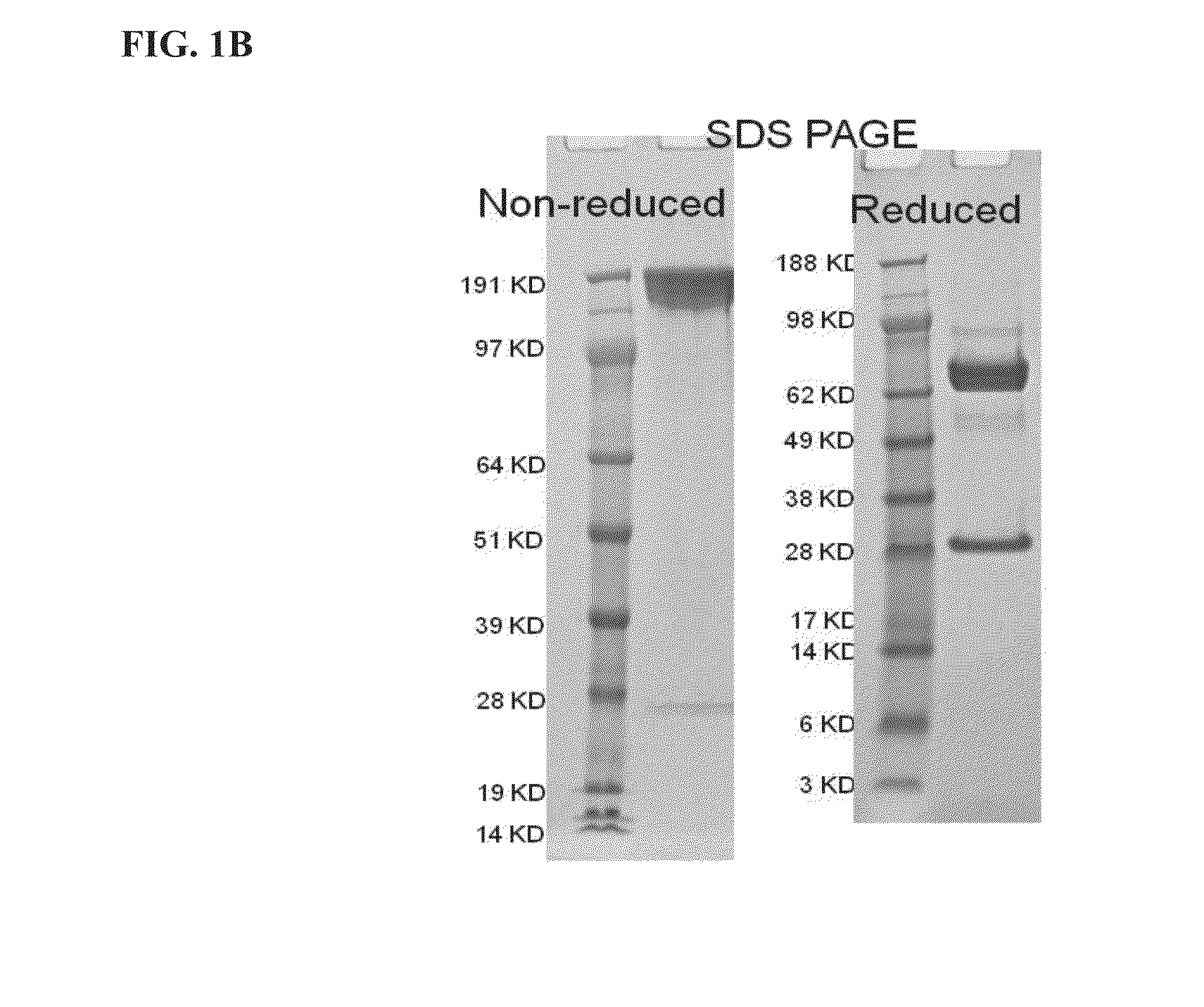Targeted tgfß inhibition
a tgfß inhibitor and target technology, applied in the field of bifunctional molecules, can solve the problems of resistance to ipilimumab therapy, high toxicity, and limited application of ipilimumab therapy, and achieve the effect of effective anti-tumor and anti-cancer therapy
- Summary
- Abstract
- Description
- Claims
- Application Information
AI Technical Summary
Benefits of technology
Problems solved by technology
Method used
Image
Examples
example 1
DNA Construction and Protein Expression
[0176]Anti-PD-L1 / TGFβ Trap is an anti-PD-L1 antibody-TGFβ Receptor II fusion protein. The light chain of the molecule is identical to the light chain of the anti-PD-L1 antibody (SEQ ID NO:1). The heavy chain of the molecule (SEQ ID NO:3) is a fusion protein comprising the heavy chain of the anti-PD-L1 antibody (SEQ ID NO:2) genetically fused to via a flexible (Gly4Ser)4Gly linker (SEQ ID NO:11) to the N-terminus of the soluble TGFβ Receptor II (SEQ ID NO:10). At the fusion junction, the C-terminal lysine residue of the antibody heavy chain was mutated to alanine to reduce proteolytic cleavage. For expression of anti-PD-L1 / TGFβ Trap, the DNA encoding the anti-PD-L1 light chain (SEQ ID NO:4) and the DNA encoding the anti-PD-L1 / TGFβ Receptor II (SEQ ID NO:5) in either the same expression vector or separate expression vectors were used to transfect mammalian cells using standard protocols for transient or stable transfection. Conditioned culture me...
example 2
Production of Anti-PD-L1 / TGFβ Trap as a Biotherapeutic
[0178]The anti-PD-L1 / TGFβ Trap produced by transient transfection of human embryonic kidney 293 (HEK) cells was found to contain varying degrees of a clipped species, which appeared as a faint band with an apparent MW of about 60 kD on SDS-PAGE under reducing conditions (FIG. 1B). This band was confirmed to be the heavy chain of the anti-PD-L1 / TGFβ Trap cleaved at a site in the N-terminal portion of TGFβRII close to the fusion junction.
[0179]Stable clones expressing anti-PD-L1 / TGFβ Trap were generated in the CHO-S host cell line, which was pre-adapted for growth in serum-free media in suspension culture. Cells were transfected with an expression vector containing a gene encoding the anti-PD-L1-TGFβRII protein and a glutamine synthetase selection marker. Subsequent selection of stable integrants was made with L-methionine sulfoximine (MSX). Anti-PD-L1 / TGFβ Trap expressing cell lines were generated using a minipool approach, follow...
example 3
Fluorescence-Activated Cell Sorting (FACS) Analysis of Binding of Anti-PD-L1 / TGFβ Trap and Controls to Human PD-L1 on Cells
[0180]The binding of anti-PD-L1 antibody and fusion proteins on HEK cells stably transfected to express human PD-L1 was studied using the following procedure.
[0181]The following exemplary procedure was used determine PD-L1 binding by FACS:[0182]a. 50 μl serial dilutions of test samples were set up in FACS buffer.[0183]b. 50 μl of HEK cells stably transfected to express human PD-L1 at 5×106 cells / ml were dispensed to the wells with test samples and mixed.[0184]c. Plate(s) were incubated in the dark on ice for 1 hour.[0185]d. Cells were pelleted at 300× g for 5 minutes.[0186]e. Supernatant was decanted and cells were resuspended in 300 μl FACS buffer and re-pelleted at 300× g for 5.[0187]f. Sample rinse was repeated.[0188]g. Cells were resuspended in 100 μl FACS buffer containing DyLight 488 conjugated whole IgG Goat Anti-Human IgG, Fcγ (1:300 diluted).[0189]h. Pl...
PUM
| Property | Measurement | Unit |
|---|---|---|
| dissociation constant | aaaaa | aaaaa |
| dissociation constant | aaaaa | aaaaa |
| MW | aaaaa | aaaaa |
Abstract
Description
Claims
Application Information
 Login to View More
Login to View More - R&D
- Intellectual Property
- Life Sciences
- Materials
- Tech Scout
- Unparalleled Data Quality
- Higher Quality Content
- 60% Fewer Hallucinations
Browse by: Latest US Patents, China's latest patents, Technical Efficacy Thesaurus, Application Domain, Technology Topic, Popular Technical Reports.
© 2025 PatSnap. All rights reserved.Legal|Privacy policy|Modern Slavery Act Transparency Statement|Sitemap|About US| Contact US: help@patsnap.com



